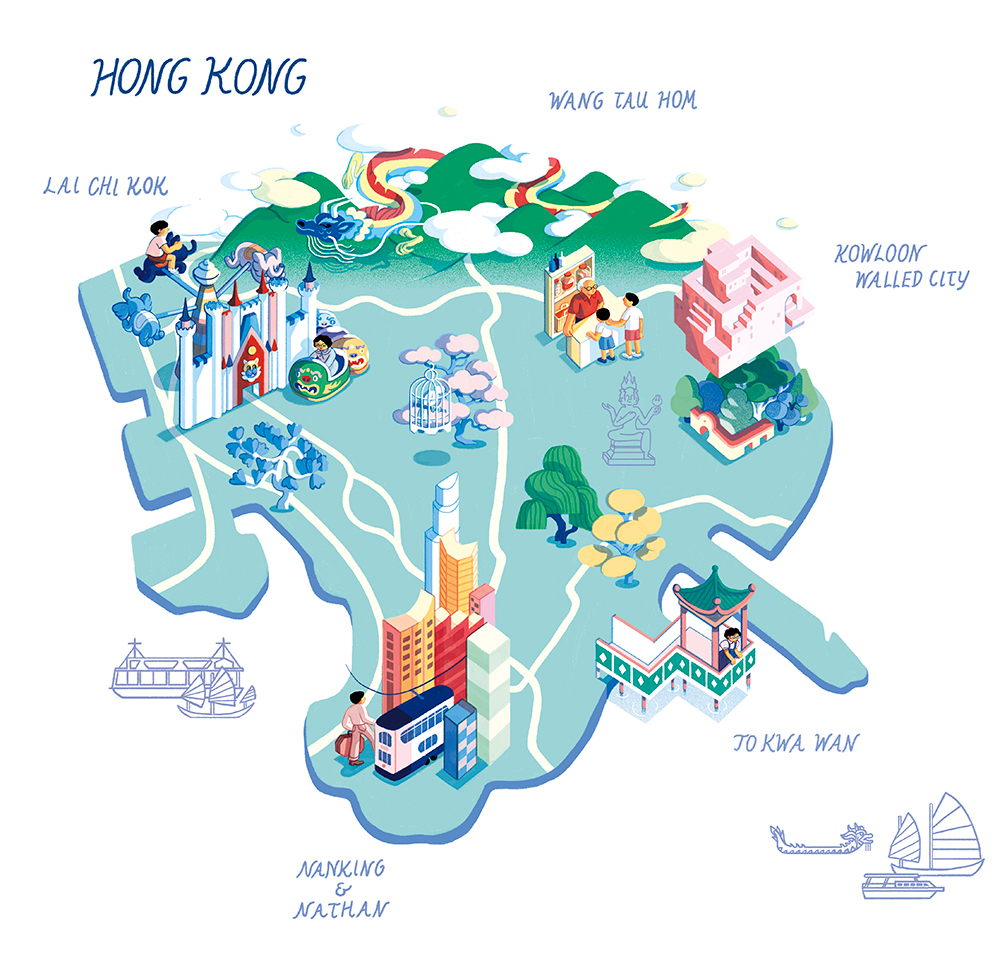Standing at the corner of Nanking Street and Nathan Road, my parents and I are looking up at the 31 storeys of Man Yee Building. Every few years my family returns to Hong Kong and my dad, Sik-On Yu ’74 BSc (CivEng), insists on a pilgrimage to all the neighourhoods where he grew up nearly 40 years ago. We get on the bus and I’m skeptical that he can find the route he took as a teenager, but he has an undeniable faith that eventually the street will bend the same way it used to, a line on a map that no longer exists.
The word “map” dates to the early 16th century from the Latin mappa mundi, which means “sheet of the world.” For my master’s thesis in humanities computing, I looked at how we map experience, rethinking city spaces with user-generated data. Some maps record distance or show you the nearest Starbucks. Others record thoughts or hold the memory of where you bumped into a friend and had a spirited sidewalk reunion. Cartographer Denis Wood asked, “What if map-making were an expressive art, a way of coming to terms with place, with the experience of place, with the love of place?” Our experience of place is personal and multilayered, meaning no map is ever accurate; rather it represents a moment. Author and historian Rebecca Solnit says each of us is an atlas, containing versions of place as experience and desire and fear, as route and landmark and memory.
Sometimes a map is less about finding a location and more about anchoring a place in time — much like my parents’ memories of growing up in Hong Kong. But Hong Kong, in a constant state of change, is unforgiving to nostalgia seekers. This merits the question: if Memory Lane is no longer visible, what do we gain from a trip down it? As our family trips to Hong Kong have shown me, a map is where we mark our stories, memories and lived experiences.
My parents met and got to know each other over pots of tea in Mae Lai Wah, a Chinese restaurant in Edmonton, where Hong Kong students and Chinese immigrants would gather. In Hong Kong, her neighbourhood (To Kwa Wan) was just 20 minutes from his. They never knew each other in Hong Kong, but they share memories of Lai Chi Kok, an amusement park. They also share the collective fear held by Hong Kong children of their generation: Kowloon Walled City. It was a lawless settlement in the larger Kowloon City that teetered between British and Chinese rule. Kids would make the trip to the walled city on a dare.
But neither of my parents dared, ever rule abiding as they were. They had heard the same rumours about it: There were only two elevators in the entire city (true). The bridges and stairways knotted together into a deep maze running through the city (also true). Entering the city meant leaving daylight behind (untrue). A single building, 14 storeys high, was home to 33,000 residents (true). It was controlled by triads and was where they hid the bodies (unconfirmed). You could hear the echo of clicking mahjong tiles against the walls (possible). The city was demolished in 1993, but its reputation and the stories live on.
My dad’s last home before he moved to Canada was on Nathan Road. Now the spot is a shopping centre and office building rising with the rest of Hong Kong in vertical waves. Nothing remains of his family home. In fact, every building that he lived in has been torn down and “going home” means going back to Canada. My dad has been in Canada for far longer than he was in Hong Kong, and often far longer than some Canadians who ask him if he’s ever planning to move back to Hong Kong.
So little remains of the life in Hong Kong that he shared with his family growing up. What remains is kept in photo albums and suitcases in the basement. But, we still go back. The last stop is at Wang Tau Hom where my dad lived with his parents and five brothers. He spent a lot of time running errands for the owner of the newsstand and convenience store. Each time we go, my dad looks for the store, and my pragmatic mom suggests that after 40 years, the store, like Hong Kong, has changed. But on this street, even though the landscape has changed, he finds where he hid from smoke bombs during riots. He finds the street corner where he walked with his brothers to school and, finally, he stands in the exact spot where that newsstand once stood. And, for a little while, he’s transported back to his childhood and can feel his family together again.

We at New Trail welcome your comments. Robust debate and criticism are encouraged, provided it is respectful. We reserve the right to reject comments, images or links that attack ethnicity, nationality, religion, gender or sexual orientation; that include offensive language, threats, spam; are fraudulent or defamatory; infringe on copyright or trademarks; and that just generally aren’t very nice. Discussion is monitored and violation of these guidelines will result in comments being disabled.